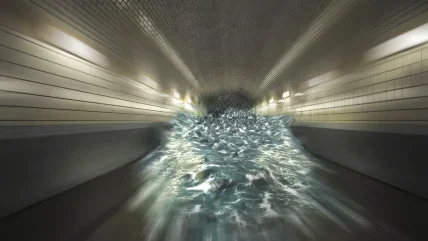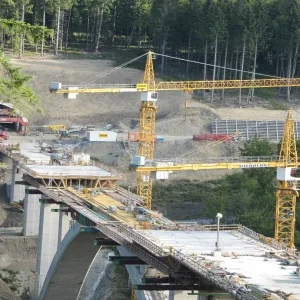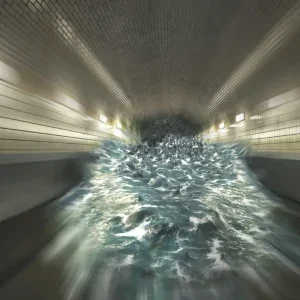
Extreme weather events, such as heavy rainfall, flooding, hurricanes, and extreme temperatures, pose significant challenges to tunnelling projects worldwide. These events can lead to project delays, increased costs, and safety hazards for workers, as well as potential damage to infrastructure and environmental impacts. Mitigating the risks associated with extreme weather is essential for ensuring the successful and safe completion of tunnelling projects. This article explores various strategies and best practices to mitigate the impact of extreme weather events in the tunnelling industry.
Understanding the Risks:
Before delving into mitigation strategies, it’s crucial to understand the specific risks that extreme weather events pose to tunnelling projects:
- Flooding and Water Ingress: Heavy rainfall and flooding can lead to water ingress into the tunnel excavation, causing delays in construction, compromising safety, and potentially damaging equipment and structures.
- Ground Instability: Extreme weather events, such as heavy rain or drought, can affect the stability of the surrounding ground, leading to soil erosion, landslides, and collapse of tunnel walls or roofs.
- Temperature Extremes: Extreme temperatures, both hot and cold, can impact the performance of construction materials, machinery, and workers, as well as affect the integrity of the tunnel structure.
- Supply Chain Disruptions: Severe weather events may disrupt the supply chain, causing delays in the delivery of materials and equipment to the construction site, thereby affecting project timelines and budgets.
Mitigation Strategies:
To mitigate the risks associated with extreme weather events in the tunnelling industry, various strategies and measures can be implemented:
- Site Selection and Planning: Conduct thorough site assessments to identify potential risks associated with extreme weather, such as flood-prone areas, unstable ground conditions, and susceptibility to temperature fluctuations. Selecting appropriate tunnel alignment and construction methods can help minimise exposure to these risks.
- Hydrological and Geotechnical Studies: Perform comprehensive hydrological and geotechnical studies to assess the potential impact of extreme weather events on tunnel stability, groundwater levels, and soil properties. Use this data to inform design decisions and implement appropriate mitigation measures.
- Waterproofing and Drainage Systems: Incorporate waterproofing membranes, grouting techniques, and drainage systems into tunnel design to prevent water ingress and manage groundwater levels during heavy rainfall or flooding events. Regular maintenance and inspection of these systems are essential to ensure their effectiveness.
- Climate-Resilient Construction Materials: Utilise climate-resilient construction materials that can withstand temperature extremes, moisture exposure, and other environmental stresses. Consider factors such as thermal expansion, contraction, and durability when selecting materials for tunnel construction.
- Monitoring and Early Warning Systems: Implement real-time monitoring and early warning systems to track weather conditions, groundwater levels, and ground movement during tunnelling operations. Automated sensors, satellite imagery, and weather forecasting tools can provide timely alerts and enable proactive risk management.
- Contingency Planning and Emergency Response: Develop contingency plans and emergency response protocols to address potential disruptions caused by extreme weather events. Establish clear communication channels, evacuation procedures, and contingency measures to ensure the safety of workers and minimise project downtime.
- Collaboration and Stakeholder Engagement: Foster collaboration and engagement with stakeholders, including government agencies, local communities, and environmental organisations, to address shared risks and build resilience against extreme weather events. Encourage knowledge-sharing, risk-sharing agreements, and coordinated response efforts to enhance project resilience.
- Climate Adaptation and Resilience Planning: Integrate climate adaptation and resilience planning into tunnelling projects from the outset, considering long-term climate projections and potential changes in weather patterns. Design infrastructure with built-in flexibility and adaptive capacity to withstand future climate challenges.
Case Studies and Best Practices:
To illustrate the effectiveness of these mitigation strategies, consider the following case studies and best practices from tunnelling projects around the world:
- Crossrail Project, London, UK: The Crossrail project implemented a comprehensive risk management strategy to mitigate the impact of extreme weather events, including flooding and ground instability. Measures such as waterproofing membranes, dewatering systems, and real-time monitoring helped minimise disruptions and ensure project success.
- Gotthard Base Tunnel, Switzerland: The Gotthard Base Tunnel, one of the world’s longest and deepest railway tunnels, employed advanced geotechnical monitoring and early warning systems to manage risks associated with ground instability and temperature extremes. Continuous monitoring of tunnel conditions enabled proactive risk mitigation and optimised construction schedules.
- East Side Access Project, New York City, USA: The East Side Access project utilised climate-resilient construction materials and innovative waterproofing techniques to address risks related to flooding and groundwater ingress in the tunnel excavation. Collaboration with local authorities and community stakeholders facilitated effective emergency response and minimised project delays.
Conclusion:
Mitigating the risks of extreme weather events in the tunnelling industry requires a proactive and multi-faceted approach that integrates site selection, design considerations, construction techniques, and risk management strategies. By incorporating climate resilience into tunnelling projects and implementing robust mitigation measures, stakeholders can minimise the impact of extreme weather events and ensure the safe and successful completion of infrastructure projects for future generations.







